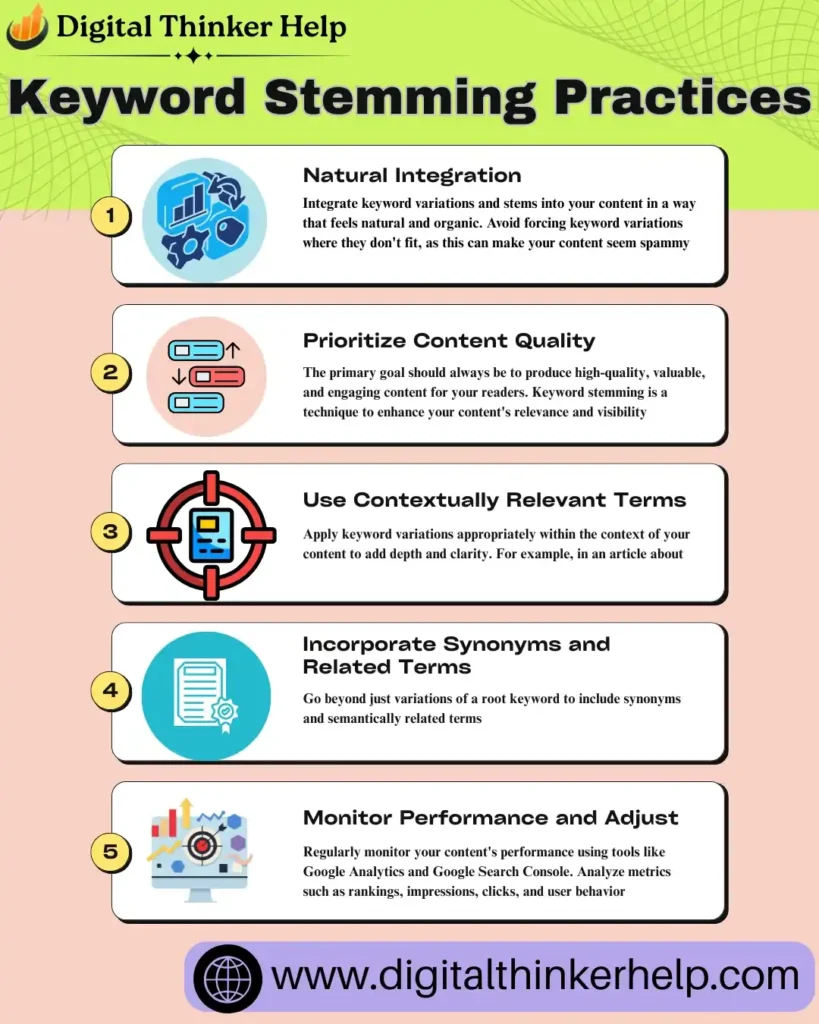Keyword stemming is a technique in language processing that clarifies words to their root design, called the stem. This helps search systems understand different variations of the same word. By using stemming, search results are more likely to match what a user actually plan during they type a keyword, creating searches more accurate and to the point.
Using keyword stemming in your online store lets to helps make search results more material by comprehension different forms of a word. This improves the overall shopping experience for users and able to also attract more visitors to your site.

In this blog, we’ll explore keyword stemming in detail what it is, why it matters, how it works with SEO, and real-world examples. You’ll get all the essential information you need to understand and use keyword stemming effectively.
What is Keyword Stemming and Why Does It Matter?
Keyword stemming is the step of reducing a word to its base form so search engines can recognize different versions of the same word.
Also Read: Keyword Prominence in SEO for Better Visibility with Examples
Other example, “run,” “running,” and “runner” all come from the root word “run.” This is important for SEO because it lets your content appear in searches alike related terms without having to repeat every variation.
Using proper stemming build search results more to the point, improves the user experience, boosts visibility, and avoids overloading your content with keywords.
Importance of Keyword Stemming in SEO
Keyword stemming offers many benefits like search engines, content creators, and website visitors. Some of the point’s advantages include:
Help to Google for Giving Relevant Results
Keyword stemming helps Google deliver more material search results. Without it, Google would only show results that exactly match the keyword typed by the user, missing related variations that power more useful.
Without keyword stemming, the number of results Google can show would be limited. It would also mean Google power only display pages containing the exact keyword, even if other content better matches what the user is really looking like.
This helps visitors get more to the point results, even if the pages don’t include the exact keyword they searched like.
Bloggers Easily Rank for Related Content
Keyword stemming helps bloggers rank for related keywords they didn’t specifically target, bringing more organic traffic and potential leads to their site.
It also lets bloggers write naturally. If they tried to optimize for every stemmed keyword, their content could become awkward, stuffed with keywords, and less enjoyable for readers.
How Google Analyzes Keyword Stemming?
Google realize keyword stemming by examining different forms of a word and how these words are connected. This also involves LSI keywords terms that are conceptually related which help Google understand the context and provide more to the point search results.
This means Google capable of realize words that are similar or related, like “run,” “jog,” and “sprint.” When anyone searches, Google uses this to show the most proper pages not just ones with the exact word typed.
This way, Google delivers better results by focusing on the meaning behind the search.
Keyword Stemming-SEO Tips and Best Practices
Keyword stemming is useful for SEO because it helps a website rank like different change of a keyword. Other example, if a site is optimized alike “jump,” it managed to also pop up in searches for “jumps,” “jumping,” and “jumped.”
Also Read: Keyword Proximity in SEO and Its Importance for Better Rankings
To create the most of keyword stemming alike SEO, you must focus on the following steps:
Identify Root Keywords: First, you have to need finding primary keywords related to your website. These are the words you’ll focus on when optimizing your content.
Apply Variations of Root Keywords: Include different forms of your main keywords like plural, singular, and various tenses unchanged your content. This helps search engines see that your content is to the point like a wide range of related searches.
Always Use Synonyms & Related Terms: Next to involve variations of your main keywords, add synonyms and related words in your content. This helps search engines recognize the context and meaning of your pages better.
Use Keyword Tools: There are many tools that manage to help you find the most important keywords and their variations like your business. These tools are great for discovering new keyword ideas and improving your content.
Examples of Stemming in Action
there are some important example that you must be knowing about them, including:

Basic Verb Forms
Walking → Walk
Danced → Danc
Writes → Writ
Adjectives and Adverbs
Happily → Happi
Quicker → Quick
Easiest → Easi
Nouns with Prefixes or Suffixes
Unhappiness → Unhappi
Connection → Connect
Operators → Operat
Complex Word Forms
Disagreement → Disagree
Normalization → Normal
Automatically → Automat
Words with Multiple Affixes
Unbelievably → Unbeliev
Reconsideration → Reconsid
Undesirable → Undesir
Words That Might Pose Challenges
Caring → Car (This can be problematic as “car” and “caring” are contextually different)
Dying → Dy (Here, the stemmed word “Dy” doesn’t hold contextual value)
Common Mistakes to Avoid
Even experienced marketers can develop habits that hurt effective keyword stemming.
Also Read: Keyword Density in SEO – And Why Does Matters It in SEO?
Here are some common pitfalls to watch out for:
Overloading Your Content with Variants
Avoid overloading your content with variants. Even still keyword stemming helps, do not force every version of a word into your post. Doing so Manage to create your writing difficulty and harder to read.
Ignoring Synonyms and Contextual Relevance
Don’t ignore synonyms and context. Include related words and synonyms to give your content more contexts. Good content doesn’t just repeat keyword variations it also explains the meaning.
Forgetting to Optimize Title Tags and Meta Descriptions
Don’t forget to optimize title tags and Meta descriptions. Keyword stems matter in metadata too. For your better understanding; if page titled “Optimizing Your Campaigns for Better ROI”; then can still rank on many searches like as “campaign optimization” or “how to optimize campaigns.”
FAQs (Frequently Asked Questions)
What is Keyword Stemming & Meaning?
Keyword stemming is the process of using a root word to find its different forms. For example, from “marketing,” you managed to get “marketer” and “marketable.” This approach helps SEO professionals for target more keywords naturally that improving content relevance and visibility without repeated keywords.
Is Keyword Stemming a Ranking Factor?
No, keyword stemming isn’t a direct ranking factor. Google uses stemming to understand the meaning of your content and match it to search queries, helping meet user intent. However, deliberately adding stemmed keywords won’t automatically boost your rankings in search results.
Can Keyword Stemming Hurt SEO?
Keyword stemming usually doesn’t harm SEO. Problems only arise if you overuse keywords or force too many variations into your content. If you write naturally, keyword stemming won’t be an issue.
Does Keyword Stemming Work for Long Tail Keywords?
Yes! Keyword stemming works for long-tail keywords too. For example, if your blog is about “how to cook pasta,” it managed to also rank alike searches like “cooking pasta tips” or similar queries.
Final Thoughts
As result of this content; keyword stemming in SEO means including different forms of your main keywords in your content.
Also Read: Keyword Stuffing in SEO & How to Avoid and Check it? Examples
This constructs your website more visible, attracts more visitors, and ensures your pages match what people are searching for.
As Google’s algorithms improve, knowing how to use different word forms successfully is point to getting better SEO results.
